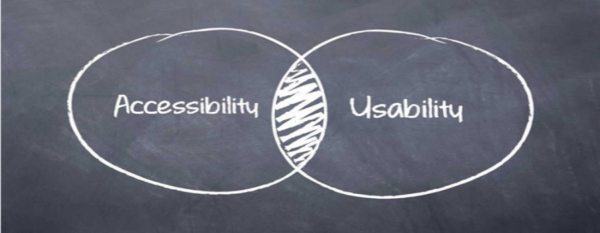
Let’s explore usability meaning in a somewhat mathematical term.
Parent set – Universal design {accessibility, usability, inclusion}.
However, accessibility ? usability but usability ? accessibility. Math is fun, right?
But here’s the thing, English is complex. Emphasis on “usable” and “accessible”. I’ll leave you to ponder about those two words before you get to the end of this article.

Let’s be clear; usability is not a synonym for accessibility; the two terms are similar in that they share some universal principles but are quite different. One sure thing is they are both related conditions for creating, designing, and developing universal web (websites and applications) and experience design that works for everyone. To analyze the association and distinction from the lens of user experience, we must first understand the uniqueness of the two phenomena.
What is Web Usability?
Let’s examine the International Standards Organization’s (ISO 9241 – 11) definition of usability as the “effectiveness, efficiency, and satisfaction with which specified users achieve specified goals in particular environments”. This will translate to how easy the interfaces are to understand and operate by the web user.
From the ISO’s usability meaning, web usability refers to a website’s ease of use. This means ensuring that the web content is presented concisely, and essential items are placed in appropriate areas to facilitate smooth interaction. In other words, usability relates to the quality of the web user’s experience when interacting with the website, the efficiency with which they can accomplish a task, and the satisfaction of the users completing the task.
Good usability ensures your users can interact with the website, complete they need to do, so easy to the point that it will “just work”. That is, good usability should go unnoticed. Often times, usability encompasses user experience of all web users but do not immensely or sufficiently cater to the needs of those living with disabilities.
What is Web Accessibility?
Web accessibility is when all web content can be accessible by being perceivable, operable, and understandable to all users, including disabled users who access it with assistive technologies. This means people with disabilities who suffer from any physical, cognitive issues, visual impairments, have hearing impairments or perhaps are elderly can make use of the web without barriers.
Accessibility has an emphasis on granting web access to people with diverse disabilities and methods of access without them facing any barrier. By so doing, information must be provided through multiple sensory channels, such as sound and sight – this will then translate to “primarily making web content accessible to individuals with impairments and indirectly to ALL users in general”.
Usability and Accessibility
Usability and accessibility address different issues, but they are similar in principle. Usability deals with ease of use. This is due to the site’s organization, navigation, visual design, page layout, and content. It also plays an important role in providing users easy ways to circumvent roadblocks on the web, to fix errors, and to re-adapt to the website or application system and its functionality with minimum learnability.
Web Accessibility primarily refers to designing for individuals with all forms of disabilities, but it benefits all types of users by presenting the web content through multiple sensory channels, such as sound and sight. A good example of cross-functionality of web accessibility is providing captions for the video on your website. This will not only ensure blind users or those with visual impairments can access the same information as all other abled users, but it will benefit even abled people in noisy environments who will then have to make use of the caption to understand the video. In other words, accessibility requirements improve usability for everyone.
As you can now see, usability and accessibility are slightly different lenses to assess user experience. The two can be significantly different- in that accessibility have technical requirements that relate to the underlying code e.g. ensuring websites work well with assistive technologies; aspects that are typically not a focus of usability principles and practices. They can as well overlap- with requirements that relate to user interaction and visual design e.g. understandable instructions and feedback for website forms and applications is good usability and at the same time, help people with cognitive and learning disabilities. Another related crucial element of web usability design and accessibility guidelines is making sure that content works on different browsers and devices.
There is the possibility of an accessible website to be difficult in usage if the ‘accessibility’ is only considered technically with no regard to the ‘accessibility’ of the interface. The site could well be accessible but it is not easy to use. The same thing will happen if we consider usability in the interface only, in this case, the site could well be easy to use by abled users, but it does not necessarily mean disabled users will conveniently access the website.
When accessibility is combined with usability principles, web design is technically and functionally accessible and usable by all users. When usability techniques such as user interface and user experience are introduced to the requirements of accessibility, we have what is known as accessible user experience or usable accessibility. Now, this brings us to user experience testing.
Evaluating Web Usability and Web Accessibility for Usable Accessibility
To reconcile usability and accessibility, web designers and developers can, first of all, consider accessibility technically, then combine usability principles and techniques to address the user interface component (secondary channel) of accessibility for the ultimate experience design.
Another important aspect of considering people with disabilities is their inclusion in common practices. This involves incorporating “real people” (including those with disabilities) in any usability design as well as the use of accessibility guidelines, standards, and techniques for the development and evaluation of the product.
In other words, you need to instill diversity in test subjects when performing user experience testing. That is the consideration of persons with disabilities who regularly use assistive technology when creating usability testing methods, selecting test pools, and not just the ‘average abled user’ as it could create a gap in testing methodology. For example, abled users may well access a new navigation menu or use the web without the keyboard. In contrast, blind and low-vision web users mail fail to access it due to insufficient color contrast or due to keyboard inaccessibility.
Like testing for usability, “real people” who provide a manual review of your website play the most crucial role in testing for web accessibility and reviewing website code. This is after automatic testing has been done to test your site against the international standard for web accessibility, the Web Content Accessibility Guidelines (WCAG) 2.0 A/AA to identify more frequent issues on a site.
Conclusion
Typically, traditional user interface testing does not consider the disabled user. Web usability involves efficiency and effectiveness in the use of the website, while web accessibility focuses on making the website accessible to individuals with disabilities. But accessibility is a fundamental prerequisite for usability since a highly usable site will include best practices of accessibility. In order words, accessibility is considered a by-product of a highly usable website.
Using either approach only could result in an inaccurate view of your site’s user experience while evaluating your website with both in mind leads to experience design and gives all users the best possible user experience. In doing this, you must consider the audience and the context (of the content or design) to enable quality user experience. For cost-effectiveness, accessibility analysis should be performed first to remove accessibility barriers before testing for usability. On completion of implementation, more user tests should be performed with diverse users to identify specific ease-of-use challenges.
By testing for both usability and accessibility, monitoring results, and remediating issues, you can benefit all users. It is possible to have a website with high satisfaction and strong usability for abled users with the mindset that these are your ‘average site users”. With about 15% of the world population suffering from a form of disability, your website may be entirely inaccessible to a large group of people (about 60 million in America). By testing for usability and accessibility using real people, you will ensure that your site meets the standards of quality, efficiency, and satisfaction, and it is perceivable, operable, understandable, and compatible with assistive technologies used by individuals with disabilities to interact with the web content.
More importantly, before developing or creating designs, designers and developers should give considerable thought to a site’s organization, navigation, visual design, page layout, and content accessibility. This is to ensure your website benefits ALL users from the code level to the visual.
At the end of the day, we can say that accessibility is a subset of usability, considering that a website is not usable unless it is accessible. However, while usability does imply accessibility, accessibility does not necessarily imply usability.
Math solved, English explained.
Digital & Social Articles on Business 2 Community
(59)
Report Post







